Science-based and sustainable hunting is one of the tools for maintaining the biodiversity and ecological balance of ecosystems

Today, hunting is not just a method of food supply or entertainment, but an important measure of environmental management. It aims to keep game numbers within reasonable limits that are acceptable to humans, but hunting is also necessary to prevent and control outbreaks of diseases (such as scabies, African swine fever) and damage caused by game animals. Thus, science-based and sustainable hunting is one of the tools for maintaining the biodiversity and the ecological balance of ecosystems.
Laws, regulations, and other legislation govern hunting and everything hunting-related. The Hunting Act provides for the creation and use of hunting districts, monitoring of wild game, harvest quotas and structure, and other principles of hunting. The act also determines the documents certifying the right to hunt, provides for the compensation for damage caused by wild game, and establishes the state supervision and liability.
The Ministry of the Environment and the authorities of its administrative area are responsible for the development of the hunting policy, as well as the regulation and supervision of the field. The Environment Agency has an important role to play in science-based hunting, organising national monitoring of wild game and preparing an annual game monitoring report. The monitoring report includes a description of the status of the game population and its changes, forecasts of changes in the status and risk factors, and recommended game harvest quotas and structures. The report prepared by the Environment Agency is one of the most important inputs to the Environmental Board and county hunting councils in making decisions concerning the management and protection of game populations (see the status of game populations and the hunting recommendation 2022, earlier reports can be found here). The Environmental Board issues hunting permits and approvals, coordinates the work of hunting councils, assesses predator damage, and advises hunters and land owners.
Hunting associations play a key role in hunting, bringing together hunters on a voluntary basis. The umbrella organisation of hunters is the Estonian Hunters’ Society. Its members are regional hunting associations, through which 85% of Estonian hunters belong to the Estonian Hunters’ Society.
The land owner also plays an important role in hunting. The Hunting Act gives the land owner several rights. For example, the land owner has the right, to the extent and pursuant to the procedure provided by the Hunting Act, to organise small game hunt on their land, to enter into agreements for the organisation of hunting activities on their immovable, to establish conditions for hunting on their land, including prohibit hunting etc.
There are 51 species of wild game in Estonia, of which 20 are mammals and 31 are birds. Under the Hunting Act, game is divided into big game and small game. Big game includes the moose, red deer, roe deer, wild boar, brown bear, wolf, lynx, and grey seal. The list of small game can be found in the hunting rules. Only the user of a hunting district has the right to hunt big game; the use of the hunting district is based on the permit in proof of the right to use the hunting district.
Permitted hunting methods
The Hunting Act stipulates that stalking, hunting from hides, calling hunt, driven hunt, search hunt, burrow hunt, and pursuit of game are permitted hunting methods. The hunting method depends on the game being hunted.
The hunting season in Estonia starts on 1 March and ends on the last day of February. You can see which game is hunted at a certain time from the hunting calendar.
It is prohibited to hunt:
- during prohibited periods of time;
- without valid documents proving the right to hunt;
- in a manner which endangers humans;
- in a manner which damages and destroys the natural habitat of the animal, unless otherwise provided by law or legislation established on the basis thereof;
- using self-shooting devices, explosives, electrical devices, birdlime, snares, net, poison, gas and smoke;
- pursuing the game in motorised water craft, motor vehicles and all-terrain vehicles, shooting at the game from motor vehicles and all-terrain vehicles or using motorised water craft, motor vehicles and all-terrain vehicles in another manner for shooting the game;
- using artificial light sources;
- using an aircraft;
- using crossbows, air rifles, laser sight or sighting devices for night shooting;
- game animals fleeing from a natural disaster;
- animals in a helpless situation, unless otherwise provided by law;
- by means of falconry;
- using firearms that are not hunting firearms;
- using bows that are not hunting bows within the meaning of the Hunting Act.
Last modified: 07.07.2022